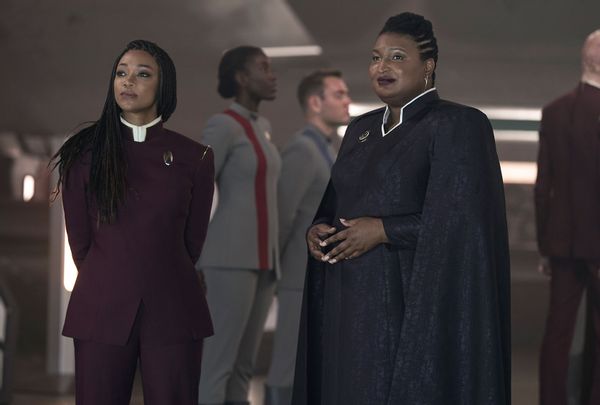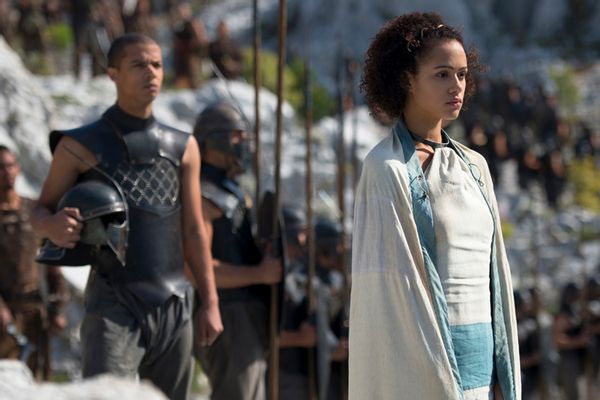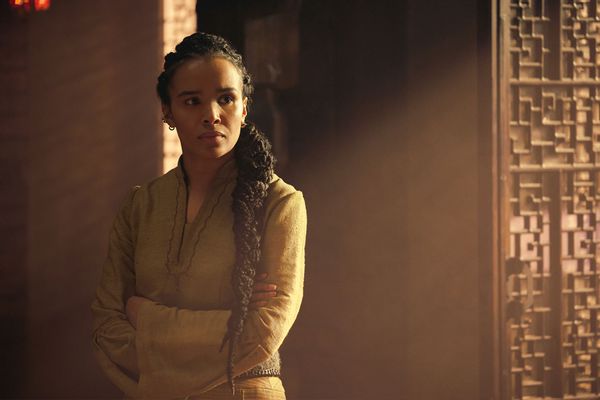
My first glimpse of Moses Ingram as Inquisitor Reva Sevander in the teaser trailer for the Disney+ show "Obi-Wan Kenobi" transported me way back, beyond the days when I watched my family's VHS tapes of "Star Wars" movies on rewind, to when I used to get my hair braided.
I'd sit between my Mom's legs as she strung white beads on my braids in pearly white rows like Venus Williams (they'd clink together like chandelier crystals whenever I turned my head). Eventually I exchanged the floor cushion for a folding chair in the middle of our living room, getting the ebonied expanse of my 4c hair traversed in micros by the dexterous fingers of a trusted family friend who came over our house to braid me and my Mom's hair.
I couldn't help but wonder how did the Imperial Inquisitor, in between hunting down rogue Jedi across the stars, get her hair done? Because, even in a galaxy far, far away, our braids demand time, a community, and special knowledge.
Later on, as a high school student, I would be at an African braiding salon all day (and some of the evening) one Saturday, with two African women standing on either side of my seat like seraphic sentinels simultaneously fusing natural coils and straight 1B hair into shoulder-length micros half the width of my pinky. I can still remember getting "my ends burned" with a cheap neon-pink lighter too, how the stubby strands at the end of a synthetic braid melted into a molten onyx tip that pricked the bare skin of my arm with a hot kiss when the stylist dropped the braid and moved on to the next one, and the next, and the next.
My childhood memories are why when I saw Ingram's immaculate cornrows in the trailer for "Obi-Wan Kenobi," I couldn't help but wonder how did the Imperial Inquisitor, in between hunting down rogue Jedi across the stars, get her hair done? Because, even in a galaxy far, far away, our braids demand time, a community, and special knowledge.
I wasn't the only one to have such speculative musings.
A few hours after the first trailer dropped, Wakandan Sith Witch (@southerncynic) tweeted a profile close-up of Ingram's coiffed cornrows as Inquisitor Reva with the description: "I'm stuck on envisioning the good sith sis making an appointment to get her hair braided before heading out to slaughter Jedi."
twitter.com/southerncynic/status/1501617481953288192
Liked and retweeted by more than 15,000 people, the post inspired a host of origin theories about how the Imperial Inquisitor gets her hair braided, the most popular of which credited Reva with either:
. . . using the Force or . . .
. . . going to a salon droid (specifically one that "specializes in protective hairstyles" according to @sagevalentine, and is "fluent in 6-million forms of hair braiding" clarifies @JoeOrgana).
Even if the hair and makeup team behind the actor's soon-to-be iconic braids didn't build an entire backstory for exactly who or what did Inquisitor Reva's hair, there was plenty of discussion surrounding the style itself.
"We had a lot of conversations about hair and what the right hair might be," explains Ingram in an interview with EW about her character. "And Deborah [Chow] was really great about moving from what the initial vision was for hair to what we arrived at for Reva's hair." The Emmy-nominated actress, who previously starred in Netflix's "The Queen's Gambit" and Apple TV+'s "The Tragedy of Macbeth," also said she wanted "Black kids with kinky hair" to be able to dress up for Halloween and talked about how this wish influenced her decision to keep her hair natural on the Disney+ show.
The (in)temporality of natural hairstyles

Ironically, many of these natural hairdos stand out because they belong in narrative worlds of the future.
"Do not be fooled by the futuristic appearance of African hairstyles," author and journalist Emma Dabiri cautions us in her 2019 book "Don't Touch My Hair," "or misled by the fact that they remain at the cutting edge of fashion. Many of the hairstyles we're talking about are ancient."
Black hair disobeys temporality as surely as it does gravity ...
Ancient indeed. Dabiri goes on to describe how traditional West African hairstyles, like cornrows, have been represented in cave paintings that date as far back as 3000 BCE as well as art and sculptures from over 2,000 years ago.
Black hair disobeys temporality as surely as it does gravity; the cornrows I wore as a 10-year-old crowned a Black woman's head a millennia ago, and will be the same cornrows a Black girl will don a millennia after I'm gone. Our natural hairstyles are nodes on a sliding timescale — the past, the present, and the Afrofuturistic — occupying the liminal spaces existing between the point in time when cornrows doubled as maps to freedom, and the points on a star chart of interwoven coordinates revealing the location of Drexciya, imagined home world of the sea-dwelling descendants of pregnant African women whom enslavers brutally threw overboard during the Middle Passage.
Black hairstyles are both changeable and yet unchanging. Are they the work of Force-powered droids with hyper-fast grippers? A braided circuit board for conducting cosmic energy?
It depends on who's telling the story. And whenever that story is being told makes no difference; cornrows and other Black hairstyles belong on whatever timeline, real or fantastical, from Westeros to deep space. And it's not that Black characters and our hairstyles belong just as much as the exotic alien characters. It's that we belong just as much as the white characters in these fantasy storylines.
Unlike on the desert planet of Tatooine or some other far-flung planet though, this truth is yet to be a reality in the world of Hollywood.
The reality of hair discrimination offscreen

Black actors in particular encounter racism even when trying to get their hair and make-up done on film and TV sets. While it's stimulating to speculate about the story-within-a-story of how a character would get her hair braided in between hunting Jedi, it's less fun to wonder how Black actors got their natural hair styled offscreen. I went to the African braiding salon to get my hair done for a reason; I couldn't just bring myself and my tightly coiled hair to Jason at the local JC Penney's salon. I went where there was special knowledge to do my natural hair in its natural state, a choice too many Black actresses and actors (who are required to use union stylists on Hollywood sets) don't have.
No matter how much a Black actor's natural hairdo is celebrated onscreen, Black hair in our everyday society is still stereotyped, crudely appropriated, and policed as being below "white beauty standards."
In order to get their hair styled for a role, Black actors have been subjected to everything from experiencing forehead burns, to being told there wasn't a "budget" to do Black hair onset, to 4 a.m. barber visits and getting their hair "cut or styled" before coming to set, while their white coworkers don't have to incur the expense or the disadvantage.
This disparity in haircare behind the scenes on film and TV sets is representative of a sad irony as we welcome more Black actors in lead roles in both contemporary and epic fantasy franchises: representation onscreen doesn't always equal respect offscreen. We celebrate the recent renaissance of leading ladies with natural hairstyles in the past couple of years, including Susan Kelechi Watson's Beth Pearson in "This Is Us" and Issa Rae's character Issa Dee in "Insecure." Still, no matter how much a Black actor's natural hairdo is celebrated onscreen, Black hair in our everyday society is still stereotyped, crudely appropriated, and policed as being below "white beauty standards [that] have been officially sanctioned in classrooms and workplaces across the country."
This is why the House of Representatives passing the Creating a Respectful and Open World for Natural Hair Act of 2022 (or the CROWN Act), a bill that "prohibits discrimination based on a person's hair texture or hairstyle" and "provides for enforcement procedures under the applicable laws," was so necessary.
Want a daily wrap-up of all the news and commentary Salon has to offer? Subscribe to our morning newsletter, Crash Course.
According to the 2021 Dove CROWN Research Study for Girls conducted by JOY Collective, "100% of Black elementary school girls in majority-white schools who report experiencing hair discrimination state they experienced the discrimination by the age of 10," and more than 40% of Black school girls ages 5-18 reported experiencing hair bias and discrimination in all school environments. Moreover, according to the 2019 version of the study, "80% of Black women said they believed they had to alter their natural hair to gain acceptance in the office."
As Black women we put our natural hair through a lot in order to personify what is perceived as "professional," "neat," and "beautiful," in a society that values a different hair texture and skin hue than ours, and we sometimes do this — with chemicals, heat, and weaves that "tame" our natural hair — even at the expense of irrevocably damaging both our coils and our physical health.
Hope from a new hair-story

I'm convinced that my scalp has never been healthier than when I used to get my baby-fist-tight coily hair braided, a long time ago. My hair had been cultivated by a community of Black women then — my Mom, an "Auntie" who was a stylist, the women in all of the braiding salons I visited — and in environments that valued care over comparisons, where I spent hours sitting at their feet or beneath their expert fingers.
Our braids pull together this inherited past, our current reality, and the future we hope for into an inheritance that simultaneously invokes, preserves, and reimagines cultural knowledge.
Because a long time ago . . . before chemical straighteners . . . before colonization and slavery . . . our women ancestors had everything we needed to care for, style, and adorn our hair. Both as a physical and symbolic exercise, our braids pull together this inherited past, our current reality, and the future we hope for into an inheritance that simultaneously invokes, preserves, and reimagines cultural knowledge.
My personal memories of braids are why I can be in awe of a bloodshot lightsaber-wielding Inquisitor from a galaxy far, far away with smart-aleck multi-appendaged droids, modeling a hairstyle from a long time ago, why I feel like I can recognize all of us in the future (past).







